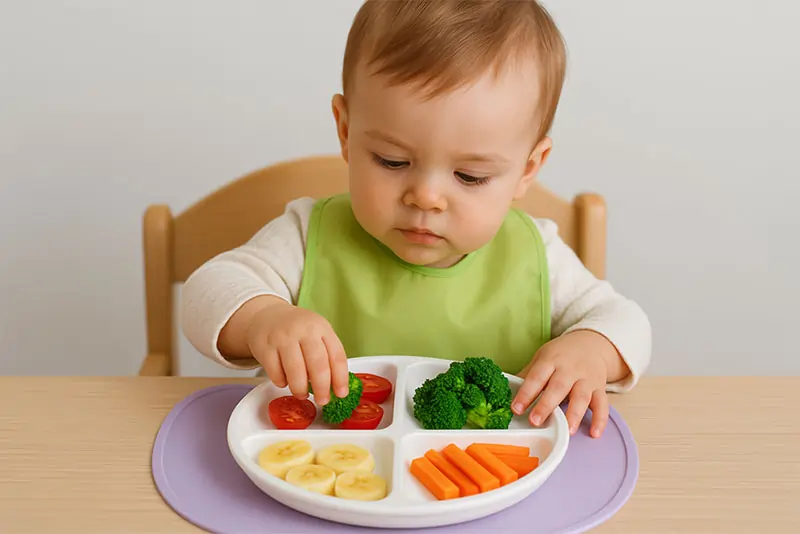Beyond the Spoon: 7 Creative Ways to Make Mealtimes Fun for Your Baby and Toddler
One of the most exciting and sometimes the hardest things about being a parent today is introducing your child to solid foods. What starts out as a simple new taste can turn into a battle of wills, with parents begging and toddlers refusing. It’s easy to forget that mealtimes should be about discovery, connection, and joy when you’re worried about making sure your child eats the right foods.
But what if we reframed our approach? Instead of viewing mealtimes as a task to be completed, we can see them as a daily adventure. By shifting the focus from just consumption to creativity, involvement, and play, we can nurture a positive and lasting relationship with food. It’s not about hiding vegetables or using secret tricks to get your child to eat more. It’s about making it fun and low-pressure for them to try new foods. Here are seven fun and useful ways to make your family’s mealtimes less stressful and more enjoyable.
1. Embrace the Mess: The Sensory Adventure
Before a baby ever tastes a piece of broccoli, they see it, smell it, and feel it. For a child, food is a full-sensory experience. While our instinct might be to keep everything spotlessly clean, allowing them to get a little messy is a crucial part of their learning process. Squishing a soft avocado between their fingers or feeling the texture of pasta is how they understand and become comfortable with new foods.
Designate a “mess-friendly zone” with a good high chair and a splat mat underneath. Instead of seeing a mess as a problem, view it as a successful interaction with food. A child who is comfortable touching and playing with their food is much more likely to eventually put it in their mouth. Provide them with safe, easy-to-clean tools and let them explore. This hands-on approach builds familiarity and reduces the fear of the unknown that often leads to food refusal.
2. Introduce “Food Art”: Eat a Rainbow
We’ve all heard the phrase “we eat with our eyes first,” and this is especially true for children. A plate of plain, monotone food can be uninspiring, but a colourful and creative arrangement can be irresistible. You don’t need to be a professional artist to make food fun.
Simple arrangements can make a world of difference. Create a smiley face using berries for eyes and a slice of banana for a mouth. Arrange colourful sliced vegetables like bell peppers, carrots, and cucumbers into a vibrant rainbow. Use a small cookie cutter to turn a slice of cheese or a piece of melon into a star or a heart. This simple act of creativity turns the plate into a canvas and the food into an invitation to play, sparking their curiosity and encouraging them to take that first bite.
Tip: You can also try playful food-related short stories for kids that make mealtimes feel magical and engaging.
3. Get Them Involved: The Little Helper
Children are far more likely to eat something they had a hand in preparing. Involving them in the meal-making process, even in the smallest ways, gives them a sense of ownership and pride. This doesn’t mean you need to let your toddler loose with a sharp knife; there are many safe, age-appropriate tasks they can help with.
A one-year-old can help wash vegetables in a bowl of water or stir ingredients in a large bowl with their hands. A two-year-old can help tear lettuce for a salad, sprinkle herbs, or press the button on the blender (with supervision). By giving them a role in the kitchen, you demystify the food and turn cooking into a fun team activity, making them more invested in the final result.
4. The Power of the Right Tools
Just as an adult enjoys drinking from a nice glass, a child’s experience can be enhanced by having tools that are designed just for them. The right dishes can help them eat on their own and do better at it. Cutlery or plates that are too big for kids or that slide around on the tray can make them feel frustrated and like they failed.
Picking the right tools is a big part of the puzzle. When you buy a carefully chosen set of beautiful and useful baby feeding items, you give your child tableware that is made for their small hands. For example, you can get ergonomic spoons that are easy to hold and suction plates that stay in place. This practical design makes everyone happier at mealtimes by reducing frustration and boosting self-feeding confidence.
5. Family-Style Serving: The Power of Choice
One of the biggest sources of mealtime stress is the power struggle. When a plate of food is placed in front of a toddler, their only choice is to eat it or refuse it. By shifting to family-style serving, you give them a sense of control and autonomy that can dramatically reduce refusal.
Instead of pre-plating their meal, try placing deconstructed components in the middle of the table (or on their high chair tray). For example, a bowl of pasta, a bowl of sauce, a bowl of cheese, and a bowl of peas. Allow your child to choose what they want to put on their plate. This “toddler charcuterie board” approach is fantastic for introducing new foods alongside familiar favourites in a low-pressure way. When they have the power to choose, they are far more likely to try something new.
6. Storytelling and Imagination: The Dinner Game
A child’s world is fuelled by imagination, and you can use this to your advantage at the dinner table. Turn the food into characters in a story. The broccoli florets can be “little trees” that a dinosaur (their fork) needs to eat to get strong. A row of peas can be “stepping stones” to cross a river.
You can also make it a game of discovery. “Can you find something red on your plate?” or “How many crunchy carrots can you count?” This takes the pressure off of “you must eat this” and turns it into a fun and interesting activity. Instead of a battle to win, mealtime becomes something to look forward to when it’s a game.
7. Lead by Example: More Than a Meal
In the end, our kids learn how to feel about food from us. Try to eat together as a family as much as you can, with everyone eating the same thing. Be a good role model by having a positive and adventurous attitude. Talk about the food in a good way, like how crunchy the carrots are or how sweet the berries are. Let them see you trying and enjoying a lot of different healthy foods.
Don’t let setbacks get you down. A child may need to try a new food 10 to 15 times before they like it. Creating a healthy food culture at home is a long-term process with lots of small wins and chances to learn. For more in-depth guides and tips on navigating this beautiful stage, exploring our baby feeding journal for modern parents can provide a wealth of supportive information and new ideas.
Conclusion
You don’t have to be a gourmet chef or a child psychologist to make mealtimes less stressful and more fun. You just need to change how you look at things. You can make a positive space that encourages curiosity and confidence by putting fun, involvement, and connection first. These little, creative tips will not only help you deal with the problems that come with having a baby or toddler, but they will also set the stage for a lifetime of healthy, happy eating.

